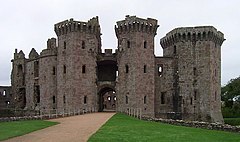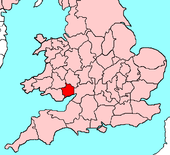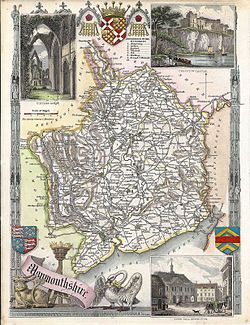Monmouthshire: Difference between revisions
mNo edit summary |
No edit summary |
||
| Line 11: | Line 11: | ||
|flower=Foxglove | |flower=Foxglove | ||
}} | }} | ||
'''Monmouthshire''' is a [[Counties of the United Kingdom|county]] in the southwest of [[Great Britain]]. The eastern part of the county is mainly agricultural, while rich mineral resources were discovered in the western valleys. This led to the | '''Monmouthshire''' is a [[Counties of the United Kingdom|county]] in the southwest of [[Great Britain]]. The eastern part of the county is mainly agricultural, while rich mineral resources were discovered in the western valleys in the 18th century. This led to the western part of the county becoming highly industrialised with coal mining and iron working becoming major employers between the 18th and late 20th centuries.<ref>{{cite web |url=http://www.visionofbritain.org.uk/place/place_page.jsp?p_id=17183 |title=Monmouthshire |accessdate=2008-08-24 |author=John Bartholomew |date=1887 |work=Gazetteer of the British Isles |publisher=Vision of Britain}}</ref> | ||
[[Monmouth]] the county town, stands at the extreme northeast of the county, on the border with [[Herefordshire]], while the largest settlement and only city, [[Newport, Monmouthshire|Newport]] lies in the southern coastal belt. The highest point is ''Chwarel y Fan'' at 2,228 feet. | [[Monmouth]] the county town, stands at the extreme northeast of the county, on the border with [[Herefordshire]], while the largest settlement and only city, [[Newport, Monmouthshire|Newport]] lies in the southern coastal belt. The highest point is ''Chwarel y Fan'' at 2,228 feet. | ||
| Line 18: | Line 18: | ||
Monmouthshire lies to the north of the Severn Estuary, which forms the county's southern boundary. Three other rivers form the majority of the county's other boundaries: The river Wye forms the eastern boundary with [[Gloucestershire]], the river Rhymney forms the western boundary with [[Glamorgan]] and the river Monnow forms the northeastern border with [[Herefordshire]]. The [[Brecon Beacons]] form the northern boundary with [[Brecknockshire]]. | Monmouthshire lies to the north of the Severn Estuary, which forms the county's southern boundary. Three other rivers form the majority of the county's other boundaries: The river Wye forms the eastern boundary with [[Gloucestershire]], the river Rhymney forms the western boundary with [[Glamorgan]] and the river Monnow forms the northeastern border with [[Herefordshire]]. The [[Brecon Beacons]] form the northern boundary with [[Brecknockshire]]. | ||
The parish of [[Welsh Bicknor]] is an | The parish of [[Welsh Bicknor]] is an exclave of Monmouthshire, sandwiched between Gloucestershire and Herefordshire. The Herefordshire hamlet of [[Cwmyoy#The parish|Fwthog]] adjoining the Honddu Valley is an exclave within Monmouthshire. | ||
===Hundreds=== | ===Hundreds=== | ||
[[Image:Monmouthshire Hundreds.jpg|thumb|250px|right|Map of the hundreds of Monmouthshire by | [[Image:Monmouthshire Hundreds.jpg|thumb|250px|right|Map of the hundreds of Monmouthshire by Thomas Moule, c. 1831]] | ||
The county was divided into six [[Hundred (division)|hundreds]] in 1542: | The county was divided into six [[Hundred (division)|hundreds]] in 1542: | ||
| Line 56: | Line 56: | ||
*[[Caerphilly]], also in Glamorgan, has its eastern suburb of Bedwas across the Rhymney River in Monmouthshire. | *[[Caerphilly]], also in Glamorgan, has its eastern suburb of Bedwas across the Rhymney River in Monmouthshire. | ||
*Maesycwmmer in Monmouthshire and Ystrad Mynach in Glamorgan form a single conurbation. | *Maesycwmmer in Monmouthshire and Ystrad Mynach in Glamorgan form a single conurbation. | ||
*Blackwood in Monmouthshire has its western suburbs across the Rhymney River in Glamorgan. | *[[Blackwood, Monmouthshire|Blackwood]] in Monmouthshire has its western suburbs across the Rhymney River in Glamorgan. | ||
*Bargoed in Glamorgan and Aberbargoed in Monmouthshire form a single town under the Bargoed Town Council. | *Bargoed in Glamorgan and Aberbargoed in Monmouthshire form a single town under the Bargoed Town Council. | ||
*New Tredegar has western suburbs across the Rhymney River in Glamorgan. | *New Tredegar has western suburbs across the Rhymney River in Glamorgan. | ||
Revision as of 12:20, 1 September 2010
| Monmouthshire Welsh: Sir Fynwy United Kingdom | |
 Raglan Castle | |
|---|---|

| |
| Flag | |
| Utrique Fidelis (Faithful to both) | |

| |
| [Interactive map] | |
| Area: | 530 square miles |
| Population: | 503,917 |
| County town: | Monmouth |
| Biggest town: | Newport |
| County flower: | Foxglove [1] |
Monmouthshire is a county in the southwest of Great Britain. The eastern part of the county is mainly agricultural, while rich mineral resources were discovered in the western valleys in the 18th century. This led to the western part of the county becoming highly industrialised with coal mining and iron working becoming major employers between the 18th and late 20th centuries.[1]
Monmouth the county town, stands at the extreme northeast of the county, on the border with Herefordshire, while the largest settlement and only city, Newport lies in the southern coastal belt. The highest point is Chwarel y Fan at 2,228 feet.
Geography
Monmouthshire lies to the north of the Severn Estuary, which forms the county's southern boundary. Three other rivers form the majority of the county's other boundaries: The river Wye forms the eastern boundary with Gloucestershire, the river Rhymney forms the western boundary with Glamorgan and the river Monnow forms the northeastern border with Herefordshire. The Brecon Beacons form the northern boundary with Brecknockshire.
The parish of Welsh Bicknor is an exclave of Monmouthshire, sandwiched between Gloucestershire and Herefordshire. The Herefordshire hamlet of Fwthog adjoining the Honddu Valley is an exclave within Monmouthshire.
Hundreds

The county was divided into six hundreds in 1542:
Cities
- Newport (51.588° N -2.998° E)
Towns
- Abergavenny (51.824° N -3.017° E)
- Blackwood (51.67° N -3.19° E)
- Blaenavon (51.773° N -3.0828° E)
- Caldicot (51.591° N -2.749° E)
- Chepstow (51.642° N -2.675° E)
- Cwmbran (51.653° N -3.021° E)
- Ebbw Vale (51.778° N -3.212° E)
- Monmouth (51.809° N -2.719° E)
- Newbridge (51.670° N -3.136° E)
- Pontypool (51.703° N -3.041° E)
- Rhymney (51.749° N -3.283° E)
- Risca (51.608° N -3.091° E)
- Tredegar (51.778° N -3.2407° E)
- Usk (51.704° N -2.902° E)
Boundary towns
The valley of the Rhymney River is extensively urbanised, such that many towns and other settlements straddle the border between Monmouthshire and Glamorgan:
- Cardiff lies in the extreme southeast of Glamorgan, such that its eastern suburbs of Rumney and St. Mellons lie across the Rhymney River in Monmouthshire.
- Caerphilly, also in Glamorgan, has its eastern suburb of Bedwas across the Rhymney River in Monmouthshire.
- Maesycwmmer in Monmouthshire and Ystrad Mynach in Glamorgan form a single conurbation.
- Blackwood in Monmouthshire has its western suburbs across the Rhymney River in Glamorgan.
- Bargoed in Glamorgan and Aberbargoed in Monmouthshire form a single town under the Bargoed Town Council.
- New Tredegar has western suburbs across the Rhymney River in Glamorgan.
Several settlements also straddle the river Wye, which forms the border between Monmouthshire and Gloucestershire:
- Chepstow lies in the extreme southeast of Monmouthshire, such that its eastern suburbs of Sedbury and Tutshill are in Gloucestershire.
- The village of Brockwier in Gloucestershire is situated on the eastern bank of the Wye such that the main access into the village is from the A466 in Monmouthshire. The former railway station on the Wye Valley line was also on the western (Monmouthshire) bank.
- The village of Redbrook straddles the border where it heads away from the river in a northeasterly direction.
Along the urbanised northern boundary with Brecknockshire is a further example of a cross-border conurbation:
- The Brynmawr-Beaufort-Nantyglo area forms a single conurbation, with the former lying in Brecknockshire and the other areas part of the industrialised Monmouthshire western valleys.
Transport
Monmouthshire lies at the junction of major routes from South Wales to London and the Midlands. Major roads include the M4 motorway from London to West Wales, the parallel A40 and A48 routes and the A465 and A449 routes to the Midlands.
Princiapal rail routes converge on Newport, including the South Wales Main Line via the Severn Tunnel, the Gloucester to Newport Line, Welsh Marches Line and Ebbw Valley Line.
The Monmouthshire canal and the Brecknockshire and Abergavenny canal converge at Pontymoile near Pontypool.
References
- ↑ John Bartholomew (1887). "Monmouthshire". Gazetteer of the British Isles. Vision of Britain. http://www.visionofbritain.org.uk/place/place_page.jsp?p_id=17183. Retrieved 2008-08-24.
This county article is a stub: help to improve Wikishire by building it up.
| Counties of the United Kingdom |
|---|
|
Aberdeen • Anglesey • Angus • Antrim • Argyll • Armagh • Ayr • Banff • Bedford • Berks • Berwick • Brecknock • Buckingham • Bute • Caernarfon • Caithness • Cambridge • Cardigan • Carmarthen • Chester • Clackmannan • Cornwall • Cromarty • Cumberland • Denbigh • Derby • Devon • Dorset • Down • Dumfries • Dunbarton • Durham • East Lothian • Essex • Fermanagh • Fife • Flint • Glamorgan • Gloucester • Hants • Hereford • Hertford • Huntingdon • Inverness • Kent • Kincardine • Kinross • Kirkcudbright • Lanark • Lancaster • Leicester • Lincoln • Londonderry • Merioneth • Middlesex • Midlothian • Monmouth • Montgomery • Moray • Nairn • Norfolk • Northampton • Northumberland • Nottingham • Orkney • Oxford • Peebles • Pembroke • Perth • Radnor • Renfrew • Ross • Roxburgh • Rutland • Selkirk • Shetland • Salop • Somerset • Stafford • Stirling • Suffolk • Surrey • Sussex • Sutherland • Tyrone • Warwick • West Lothian • Westmorland • Wigtown • Wilts • Worcester • York |